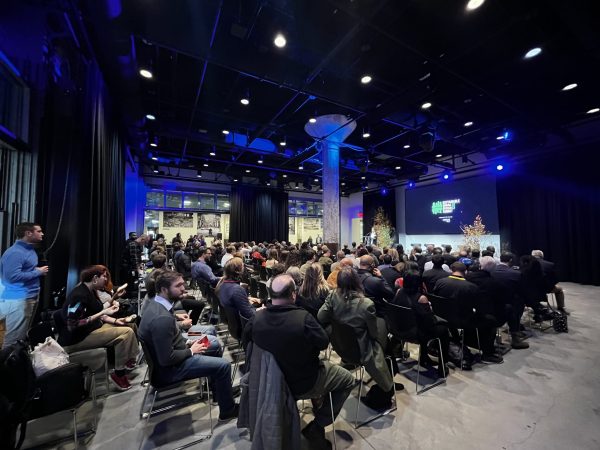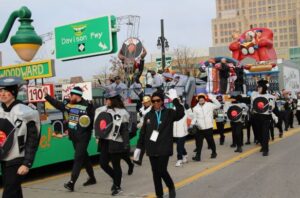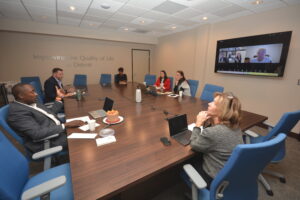On November 9, Detroitisit brought together urban planners, mobility innovators, community developers, neighborhood association leaders, and design experts from corporate, public, private, and philanthropic sectors for the third annual Sustainable Urban Design Summit focused on shaping sustainable city futures.
After focusing on the built environment in 2021, and climate, energy, and social justice in 2022, the mission of the 2023 Summit is to leverage the future-focused mindset of applying solution-based design thinking to urban development, mobility, community engagement, and readiness toward the circular economy.

CHARGING STATION
Supported by the Consulate General of the Kingdom of the Netherlands, Visit Detroit and Bedrock, the free event took place at New Lab and ran from 9 am to 9 pm.
One of the three main topics is Multimodal Mobility which will explore the impact multiple modes of mobility will have on a city and individuals who partake in it.
We spoke with Kathryn Snorrason, VP and Deputy Chief Mobility Officer with the Michigan Office of Future Mobility and Electrification (OFME) for the state of Michigan, and Tony Geara, Deputy Chief of the Office of Mobility and Innovation for the City of Detroit share some initial insights on the specific work they are doing in as it pertains to – and will lead into – thought-provoking discussions and ideas.
DII: How can Detroit become a multimodal leading city?
Snorrason: The state of Michigan has a long history in this space and we work on a lot of partnerships and programs that focus on complete trips. As an office, our vision is to be innovative in the mobility and electrification sectors and to focus on technology that meets the needs of Michigan residents.

MAY MOBILITY
We meet with mobility teams from the different cities in Michigan to understand what each is doing and how others around the state can benefit from lessons learned.
We are seeing a lot of improvements around the state from bike lanes to testing with delivery bots and infrastructure to help residents with complete trips.
Geara: Good question because we all realize the shortcomings we have in our network as a whole in the U.S. where we tend to focus on motorized vehicles. We can move beyond this by having a true multimodal network and investing in it. It starts with us seeing the vision and investing.
DII: What are the main challenges to making this happen?
Snorrason: The infrastructure needed to support the mobility needs of residents now and in the future takes time to build and be adopted, so that would be one of the challenges we are faced with.
Also, funding can be a challenge. The state plays a big role in making sure businesses have the ability to grow and scale.
Geara: Funding is a hurdle. It’s not a roadblock but it’s a hurdle. We are always faced with prioritizing where the funding goes. We all realize there is a morphing urban environment we are experiencing, and we have to start listening to residents and the needs of the next generation.
For us to be a competitive city we have to overcome funding challenges, change the way we design things, and prioritize different solutions.
DII: Tell us more about the CAV project.
Snorrason: This is a first-of-its-kind connected and autonomous vehicle (CAV) corridor and it’s great to see it happening in Michigan. The project is focused on infrastructure and how we can enhance safety and support transit for our residents. I think other states will be looking to us and this as an example.
DII: How do the choices of infrastructure and transportation affect “mobility justice”?
Snorrason: When I think of mobility justice I think about helping our residents move where they need to move, as well as the movement of goods. Providing connectivity and the infrastructure to support those needs is critical.
An example is alternative fuel vehicles. Not everyone can afford them, and not all charging stations are ADA-accessible. Embedding charging in our roadways is just one solution the state is exploring.
Geara: Mobility justice is a fluid term and can mean a lot of things. Initiatives like Justice40 are helping to ensure equitable access to mobility. If a city is limited to one or two modes of transport that’s limiting the ability for certain people to be a productive part of your community.
We have to start looking at the future of mobility to ensure there are different options for all demographics at an affordable price.
DII: Where does mobility fit in as it relates to the citizen-scape and the urban-scape?
Snorrason: It plays a huge role – how are you moving people around to access the goods and services they need such as going to the doctor, work, and school or how do we bring those services to you? It’s about quality of life for Michiganders, but also attracting companies to the state.
Geara: It’s almost like saying can your body survive without a heart and arteries. One is the actual destination and the other is the vessel through which you get to the destination. It’s all part of one big system.
One of biggest things when approaching this is ensuring we are thinking holistically. People need to go to the doctor and to run errands, and they also want to go to places of joy and entertainment. If we are not thinking about all of it, we are cutting ourselves short as a city.
As always, be sure to subscribe to our newsletter for regular updates on all things Detroit.




















